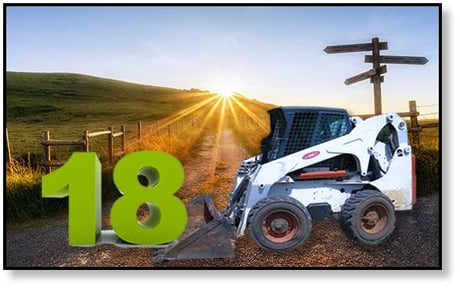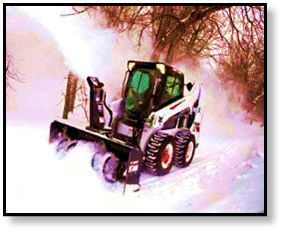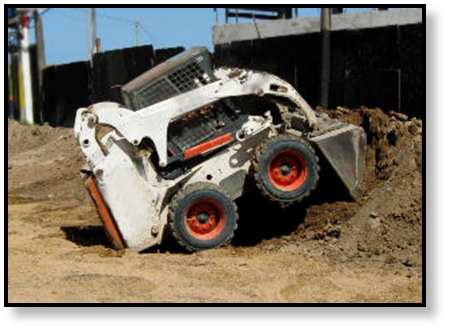mini excavator buckets
Your skid-steer represents a significant investment for your fleet. The key to getting the most out of your investment includes:

- minimizing operating costs,
- reducing downtime, and
- extending its life.
Included here are some simple maintenance and operating tips to help you minimize the costs related to your skid steers…
Want more Shop Talk Blog educational posts on the economics of Heavy Equipment, check them out:
- Effectively Cleaning a Final Drive
- 5 Reasons a Final Drive Can Lack Power (free infographic)
- Final Drives: Re-Manufactured versus Rebuilt (quick troubleshooter guide)
Your 18 Tips to Minimize Skid Steer Costs
Tip #1: Don’t spin tires when digging
Don’t spin the tires when digging. Many operators mistakenly think that this improves performance, but it does not. Instead, it just causes unnecessary (and expensive) wear on the tires.
Tip #2: Routine regular maintenance of heavy equipment
How many pieces of heavy equipment do you need in your fleet before you start a regular maintenance routine? Suprisingly, experts will tell you that the answer is 1 — even if you only own one piece of equipment, establish a routine for regular maintenance and adhere to it. It will save you money in the long run and minimize overall downtime.
Tip #3: Daily safety check
Take a few minutes to perform a daily walk-around, checking the front end, the tires, the engine, fluid levels, and safety controls. It only takes a few minutes, and gives you the information you need to prevent major problems before they start. Like the previous tip, this practice will help to minimize downtime, too.
Experiencing excessive noise and cannot figure out WHY? Check out the Excessive Noise Troubleshooter Guide (infographic) from Texas Final Drive for possible causes.
mini excavator buckets for sale
Tip #4: Clean and check skid steer
Thoroughly clean the skid steer and check it for damage every time it returns from a job site. Don’t allow mud and and other debris to build up. Not only can this damage some parts of your skid steer (like the undercarriage) but it can prevent you from spotting potential problems like leaks.
Tip #5: Weekly tire check
Always keep the tires properly inflated, referring to your manufacturer’s guidelines for proper tire pressure. You should check the pressure at least once a week — some owners and operators will check the pressure once a day. Appropriate pressure reduces wear and improves the performance of your skid steer.
Tip #6: Counterweights
Take off the counterweights when they are not needed. Using counterweights when you don’t need them can cause excess wear to some of the key components of your skid steer.
Tip #7: Use of filters and lubricants
Use the filters and lubricants recommended by the manufacturer. Your skid-steer was designed to use them. Off-brand filters may be cheaper but can cause serious damage if they aren’t good quality.
Tip #8: Prepare for freezing temperatures
I f you are expecting freezing temperatures between shifts, run your skid steer in forward and then reverse before you shut it down. This prevents a build-up of moisture that can later freeze around the undercarriage and wheels.
f you are expecting freezing temperatures between shifts, run your skid steer in forward and then reverse before you shut it down. This prevents a build-up of moisture that can later freeze around the undercarriage and wheels.
Tip #9: Check tire treads
Regularly check the tire treads for uneven wear. When you do see it — and keep in mind that it is normal for the rear tires to wear out more quickly — rotate the tires. This will to promote more even wear, and enable you tires to last much longer.
Tip #10: Minimum ground speed
Use the minimum ground speed you need to get the job done. Running your skid steer to fast will accelerate its rate of normal wear and tear and will be more costly over time.
Tip #11: Counter-rotating turns
Make your turns without counter-rotating. This will minimize wear on the undercarriage, which is usually the most expensive part of your skid steer when it comes to maintenance and repair costs.
Tip #12: What to do on slopes
When on a slope, keep the heaviest end of the machine uphill. Also try to avoid making 90° turns. Again, operator practices like these may be hard to implement initially, but it will be worth the savings in wear and tear on your equipment.
Tip #13: Travelling over a change in slope or elevation
If you must travel over a change in slope or elevation, do it with the machine at a 90° angle to the transition.
Tip #14: Skid Steer tires on roads
Keep in mind that the tires of your skid steer were not designed for roads. Keep this in mind: they will wear out far more quickly when driven on roads, concrete, or asphalt.
Tip #15: Records on maintenance and repair
Keep good records on maintenance and repairs. This can help you notice patterns in repairs or unusual wear, indicate what might be responsible for repeat machine failures, and help you make sure that you are practicing routine maintenance.
Tip #16: Daily undercarriage maintenance
Clean out the undercarriage daily, preferably using a pressure washer if one is available or simply a shovel. If debris is allowed to build up, it can can corrosion, wear, and premature failure over time.
Tip #17: Replacement of rims
Always replace wheel rims that are dented or bent. Damaged wheel rims can cause serious damage to your tires over time, which means even more expenses.
Tip #18: Check and change gear oil
Check and change the gear oil in the final drive according to manufacturer’s recommendations. Failure to do so can cause gear oil leaks to go unattended and eventually result in severe damage to the planetary side of the final drive.
Importance of Care and Maintenance
Your skid-steers will only run well if you make sure time is taken to maintain them, operate them properly, and fix problems as soon as they start.
Continued maintenance of your heavy equipment is key to longevity and always results in a healthy bottom-line. Texas Final Drive provides best-in-class remanunfactured final drive hydraulic motors when looking for the right motor. Check out the latest inventory for our CAT Skid Steer Loader Hydraulic Motors continually being updated.